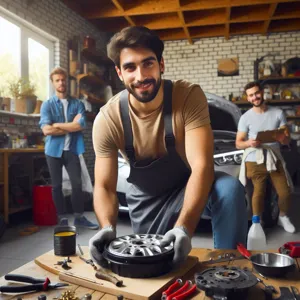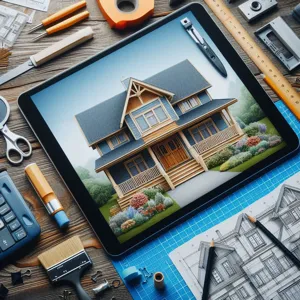Taking care of your vehicle doesn’t have to mean endless trips to the mechanic or costly service bills.
With a bit of knowledge and the right tools, you can engage in DIY car care that not only saves you money but also enhances your connection with your ride. Whether you’re a seasoned car enthusiast or a novice driver looking to learn the ropes, understanding the basics of home maintenance is key to ensuring your vehicle runs smoothly for years to come. In this blog post, we’ll explore essential tips and tricks for DIY car care that will empower you to tackle common maintenance tasks with confidence. From changing your oil and rotating tires to checking fluid levels and understanding warning lights, these practical insights will help you keep your car in top condition while giving you the satisfaction of knowing you can handle it all yourself. Get ready to roll up your sleeves and dive into the world of DIY car maintenance!
1. Introduction to DIY Car Care

In today’s fast-paced world, maintaining your vehicle can often feel like a daunting task. However, with a little knowledge and the right tools, DIY car care can not only save you money but also provide a sense of empowerment and satisfaction. Whether you’re a seasoned gearhead or a complete novice, taking the reins of your car’s upkeep allows you to develop a deeper understanding of how your vehicle operates and what it needs to stay in optimal condition.
DIY car care encompasses a range of tasks, from simple maintenance like oil changes and tire rotations to more complex repairs. By investing time in learning these skills, you can extend the lifespan of your vehicle, enhance its performance, and ensure it runs safely on the road. Beyond practicality, the act of working on your car can be a therapeutic escape, offering a productive outlet to channel your creativity and problem-solving skills.
In this blog post, we will explore the essential tips and tricks that every car owner should know, empowering you to tackle basic car maintenance with confidence. From gathering your tools to understanding the fundamentals of engine care, we’ll guide you through the DIY process, so you can keep your vehicle in top shape while enjoying the journey of car care. So grab your toolbox, roll up your sleeves, and let’s dive into the world of DIY car maintenance!
2. The Benefits of Home Maintenance for Your Vehicle
Maintaining your vehicle at home is not just a way to save money; it’s an opportunity to build a deeper connection with your car while ensuring its longevity and reliability. The benefits of home maintenance extend far beyond simply keeping your vehicle looking good.
First and foremost, regular home maintenance helps you catch small issues before they escalate into larger, more costly problems. By routinely checking fluid levels, inspecting belts and hoses, and monitoring tire pressure, you can identify potential troubles early on. This proactive approach not only saves you from hefty repair bills down the line but also enhances your vehicle’s overall performance.
Additionally, taking charge of your car care routine fosters a sense of empowerment and knowledge. You’ll become familiar with your vehicle’s parts and functions, which can be invaluable in understanding how your car operates. This familiarity allows you to make informed decisions about necessary repairs or service, ultimately giving you greater confidence during visits to professional mechanics.
Home maintenance also contributes to improved safety on the road. Regularly inspecting your brakes, lights, and tires ensures that your vehicle is in optimal condition, reducing the risk of accidents caused by mechanical failures. Moreover, a well-maintained car is often more fuel-efficient, leading to savings at the pump and reduced environmental impact.
Finally, engaging in DIY car care can be a rewarding hobby. It provides an opportunity to learn new skills and take pride in the work you put into your vehicle. Whether it’s changing your oil, waxing the exterior, or rotating the tires, each task completed successfully can bolster your self-sufficiency and inspire you to tackle even bigger projects.
In essence, embracing home maintenance for your vehicle not only enhances its performance and safety but also enriches your ownership experience, making every drive more enjoyable.
3. Essential Tools Every DIY Car Mechanic Should Have

When it comes to DIY car care, having the right tools can make all the difference between a simple maintenance task and a frustrating ordeal. As a budding mechanic, you’ll want to equip your garage with a selection of essential tools that not only boost your confidence but also ensure you can tackle a variety of car maintenance jobs with ease. Here’s a breakdown of the must-have tools every DIY car mechanic should have in their arsenal.
**1. Socket Set:** A comprehensive socket set is non-negotiable. Look for a metric and imperial set that includes a range of sizes, both standard and deep sockets. This versatile tool is essential for loosening and tightening bolts in various parts of your vehicle, from the engine to the undercarriage.
**2. Wrenches:** A good set of wrenches, including both open-end and box-end varieties, is vital for reaching those tricky bolts that sockets can’t handle. An adjustable wrench can also be a handy addition for tackling different sizes.
**3. Screwdrivers:** A variety of screwdrivers, including flathead and Phillips-head, is essential for working on various components, from dashboards to engine covers. Consider investing in a set with magnetic tips to make handling screws easier.
**4. Pliers:** A pair of needle-nose pliers can reach tight spaces, while slip-joint pliers offer versatility for gripping and twisting tasks. A set that includes wire cutters will also come in handy for electrical work.
**5. Jack and Jack Stands:** Safety is paramount when working underneath your vehicle. A high-quality floor jack and sturdy jack stands will help you lift your car securely, allowing you to work on tires, brakes, and exhaust systems without worry.
**6. Oil Filter Wrench:** Changing your car’s oil is one of the most basic maintenance tasks, and an oil filter wrench makes removing the filter a breeze. This tool will save you time and prevent the mess that can come from trying to remove it by hand.
**7. Tire Pressure Gauge:** Maintaining proper tire pressure is critical for safety and fuel efficiency. A reliable tire pressure gauge will help you keep your tires in optimal condition, ensuring a smoother ride and better gas mileage.
**8. Multimeter:** For those who want to delve into electrical systems, a multimeter is a valuable tool that measures voltage, current, and resistance. It’s essential for diagnosing electrical problems and ensuring your battery and alternator are functioning properly.
**9. Funnel and Oil Drain Pan:** When performing oil changes or other fluid maintenance, a funnel helps prevent spills, while an oil drain pan collects used oil for proper disposal. These tools keep your workspace clean and environmentally friendly.
By investing in these essential tools, you’ll be well-equipped to tackle a range of DIY car maintenance tasks. Remember, the more comfortable you become with these tools, the more confident you’ll feel taking on bigger projects and maintaining your vehicle with ease. Happy wrenching!
4. Understanding Your Car’s Owner Manual
Understanding your car’s owner manual is one of the most powerful tools at your disposal for effective DIY car care. Often overlooked, this comprehensive guide is specifically tailored to your vehicle, providing invaluable insights that can enhance your maintenance routine and extend the life of your car.
The owner’s manual is not just a collection of technical jargon; it’s a roadmap to the intricacies of your vehicle. Within its pages, you’ll find detailed information about your car’s systems and components, including fluid capacities, recommended maintenance schedules, and specifications for parts. Familiarizing yourself with this guide allows you to perform maintenance tasks with confidence, ensuring that you’re using the right products and techniques for your specific make and model.
Additionally, the owner’s manual contains vital safety information and troubleshooting tips that can help you address minor issues before they escalate into costly repairs. For instance, it might outline how to reset warning lights or check fluid levels, empowering you to take proactive steps in maintaining your car.
Don’t underestimate the value of diagrams and illustrations included in the manual, which can demystify complex components like the engine, transmission, and electrical systems. Knowing where to locate essential parts, such as the oil filter or battery, can save you time and frustration during DIY maintenance tasks.
In a nutshell, your car’s owner manual is an essential companion in your journey of DIY car care. By taking the time to read and understand its contents, you empower yourself with knowledge that not only enhances your maintenance skills but also fosters a deeper connection with your vehicle. So, before you dive into any DIY project, make sure you have that manual handy—your car will thank you for it!
5. Regular Maintenance: Oil Changes and Fluid Checks

Regular maintenance is the backbone of keeping your vehicle running smoothly and efficiently, and two of the most crucial components of this routine are oil changes and fluid checks. Think of oil as the lifeblood of your car—it lubricates the engine, minimizes friction, and helps dissipate heat. Over time, however, oil can become contaminated with dirt, debris, and combustion byproducts, leading to decreased performance and potential engine damage.
To ensure your engine stays in top shape, it’s vital to change the oil at regular intervals, typically every 3,000 to 5,000 miles, depending on your vehicle’s make and model as well as the type of oil you use. Always refer to your owner’s manual for the manufacturer’s recommendations. When changing the oil, don’t forget to replace the oil filter as well; this will help trap harmful particles and keep your new oil clean.
In addition to oil changes, fluid checks should be a routine part of your car care regimen. This includes checking the coolant, brake fluid, transmission fluid, power steering fluid, and windshield washer fluid. Each of these fluids plays a critical role in your vehicle’s performance and longevity. For instance, coolant prevents your engine from overheating, while brake fluid ensures your braking system functions effectively.
Take a few moments each month to pop the hood and visually inspect the fluid levels. Most vehicles have dipsticks or transparent reservoirs that make it easy to gauge the levels at a glance. If any fluids are low, top them off with the appropriate type, and if you notice any leaks or discoloration, it may be time to consult a professional.
By prioritizing regular oil changes and fluid checks, you’ll not only enhance your car’s performance but also extend its lifespan, ultimately saving you time and money in the long run. So roll up your sleeves, grab your tools, and give your vehicle the care it deserves!
6. Checking and Replacing Air Filters
Maintaining the health of your car’s engine and ensuring optimal performance often hinges on a simple yet frequently overlooked component: the air filter. Checking and replacing air filters is a crucial aspect of DIY car care that can significantly impact your vehicle’s efficiency and longevity.
Air filters serve as the lungs of your vehicle, filtering out dust, dirt, and debris from the air entering the engine. Over time, these filters can become clogged, restricting airflow and causing your engine to work harder than necessary. This not only leads to decreased fuel efficiency but can also result in increased emissions and diminished overall performance.
To begin, locate your car’s air filter—typically found within the engine compartment, often near the top of the engine or within a dedicated air intake box. Refer to your owner’s manual for specific instructions on how to access it, as the design can vary widely between makes and models. once you’ve located the filter, inspect it closely. A clean filter will be light in color and free of significant debris, while a dirty one may appear dark, dusty, or even damaged.
If your air filter shows signs of wear or is excessively dirty, it’s time for a replacement. This is a relatively simple task that usually requires just a few basic tools. Remove the old filter and gently clean the area surrounding it to eliminate any accumulated dust or grime. Installing the new filter is often a matter of sliding it back into place and securing any clips or screws.
It’s advisable to check your air filter every 12,000 to 15,000 miles, or as recommended by your vehicle’s manufacturer, and replace it as necessary. Not only will this small effort enhance your car’s performance, but it will also contribute to a smoother and more efficient ride. By prioritizing the health of your air filters, you’re taking a proactive step in your DIY car maintenance routine that can lead to noticeable improvements in fuel economy and engine responsiveness.
7. Tire Care: Rotating, Balancing, and Pressure Checks

When it comes to DIY car care, tire maintenance is often overlooked, yet it’s one of the most crucial aspects for ensuring both safety and performance. Properly maintained tires not only enhance fuel efficiency but also improve handling and extend the life of your tires, making tire care an essential component of home maintenance.
**Rotating Your Tires**
Tire rotation involves changing the position of each tire on your vehicle to promote even wear. This is particularly important for front-wheel-drive vehicles, where the front tires bear the brunt of steering and braking forces. As a general rule, you should rotate your tires every 5,000 to 7,500 miles, or as recommended by your vehicle manufacturer. A simple rotation can save you money in the long run by extending the life of your tires and providing a smoother ride.
**Balancing Your Tires**
Balancing ensures that the weight of the tire and wheel is evenly distributed. When tires are unbalanced, you might notice vibrations while driving, which can lead to uneven wear and additional strain on your suspension system. You can have your tires balanced at most tire shops, but it’s a good idea to check them every time you rotate your tires or if you notice any unusual handling characteristics.
**Pressure Checks**
Tire pressure is a critical factor in car safety and efficiency. Under-inflated tires can lead to poor handling, decreased fuel economy, and increased wear, while over-inflated tires can make your ride uncomfortable and increase the risk of a blowout. Check your tire pressure at least once a month and before long trips. Use a reliable tire pressure gauge to ensure your tires are inflated to the manufacturer’s recommended PSI, typically found on the driver’s side door jamb or in your owner’s manual.
By incorporating regular tire rotations, balancing, and pressure checks into your DIY car care routine, you’ll not only enhance your vehicle’s performance but also ensure a safer and more enjoyable driving experience. Remember, well-maintained tires are your car’s only contact with the road, so give them the attention they deserve!
8. Brake Maintenance: Signs of Wear and DIY Inspection
When it comes to vehicle safety, brake maintenance is non-negotiable. Your brakes are the critical component that ensures you can stop your vehicle effectively, and neglecting them can lead to serious consequences. Regular DIY inspections can help you stay ahead of any potential issues and keep your brakes in top condition.
First, familiarize yourself with the key signs of brake wear. Squeaking or squealing sounds when you press the brake pedal often indicate that the brake pads are worn and may need replacement. If you hear a grinding noise, it’s a strong signal that the brake pads are completely worn down and could be damaging the rotors. Additionally, if you notice your vehicle pulling to one side when braking, it could mean uneven wear on the brake pads or issues with the brake lines.
To conduct a DIY brake inspection, start by safely elevating your vehicle using jack stands. Remove the wheel to access the brake components. Look for any visible signs of wear on the brake pads—generally, if the pad material is less than a quarter-inch thick, it’s time for a replacement. Check the rotors for grooves or scoring, which can also indicate they need resurfacing or replacing. Don’t forget to inspect the brake lines for any signs of leaks or cracks, which could lead to brake failure.
Lastly, remember to check the brake fluid level in the reservoir. Low fluid can affect braking performance and may indicate a leak in the brake system. If you notice any of these signs during your inspection, it’s wise to consult a professional or consider a DIY brake replacement if you feel confident in your skills. By regularly inspecting your brakes and addressing issues early, you can ensure your vehicle remains safe and responsive on the road.
9. Battery Maintenance: Testing and Cleaning Tips
Maintaining your car’s battery is a crucial aspect of DIY car care that often gets overlooked. A well-maintained battery not only ensures that your vehicle starts reliably but also extends its lifespan, saving you money in the long run.
To begin with, regular testing of your battery’s voltage can help you catch potential issues before they escalate. Invest in a simple multimeter to check the battery’s voltage. A healthy battery should read around 12.6 volts when the engine is off. If the reading falls below 12.4 volts, it’s time to consider recharging or replacing it. Additionally, if you notice any dimming lights or slow cranking when starting your car, these are signs that your battery may be struggling.
Cleaning your battery terminals is another vital step in maintenance. Over time, corrosion can build up on the terminals, leading to poor connections and potential starting issues. To clean them, first, ensure the engine is off and the keys are removed. Using a mixture of baking soda and water, apply the solution to the terminals with a small brush, such as an old toothbrush. The baking soda will neutralize any acid corrosion. Rinse with clean water and dry thoroughly before reattaching the terminals. For extra protection, consider applying a thin layer of petroleum jelly on the terminals after cleaning; this will help prevent future corrosion.
Lastly, don’t forget to check the battery’s electrolyte levels if you have a traditional lead-acid battery. If the levels are low, simply top them up with distilled water to ensure optimal performance. By incorporating these simple testing and cleaning tips into your car maintenance routine, you can keep your battery in top shape, ensuring your vehicle starts smoothly every time. With just a little effort, you can extend the life of your battery and enjoy peace of mind on the road.
10. Wiper Blades and Lights: Importance of Visibility
When it comes to DIY car care, ensuring that your vehicle is equipped with functional wiper blades and properly working lights is crucial for maintaining visibility and safety on the road. These often-overlooked components play a vital role in your driving experience, particularly during adverse weather conditions or in low-light situations.
Wiper blades are your first line of defense against rain, snow, and dirt that can obscure your windshield. Over time, wiper blades can wear out, becoming brittle or cracked, which diminishes their effectiveness. To maintain optimal visibility, it’s essential to inspect your wiper blades regularly. If you notice streaks or smears on your windshield, it’s time to replace them. Many drivers don’t realize that replacing wiper blades is a simple task that can be done at home—most come with easy-to-follow instructions, and you can find replacements at any auto parts store. Keeping a fresh set on hand ensures that you’re always prepared for sudden weather changes.
Equally important are your vehicle’s lights. Headlights, taillights, brake lights, and turn signals are critical for communicating your presence and intentions to other drivers. A burnt-out bulb can not only lead to dangerous situations but can also result in traffic violations. Regularly check all your lights to ensure they are functioning correctly. If you notice a dim or non-working bulb, replace it promptly. This not only enhances your visibility but also ensures that you’re seen by others on the road.
Moreover, consider upgrading to higher-quality bulbs that offer brighter illumination and longer life spans. There are numerous options available, including led and HID bulbs, which can significantly improve nighttime driving and overall visibility.
In summary, prioritizing the maintenance of your wiper blades and lights is essential for safe driving. By taking the time to check and replace these components as needed, you not only enhance your visibility but also contribute to the safety of yourself and others on the road. So, grab your tools and make it a regular part of your DIY car care routine—your future self will thank you!
11. Exterior Care: Washing, Waxing, and Protecting Paint
Caring for your car’s exterior is not just about aesthetics; it’s an essential part of maintaining its value and longevity. A well-kept exterior not only looks good but also protects your vehicle from the elements, ensuring that it remains in top condition for years to come. Let’s dive into the crucial steps of washing, waxing, and protecting your car’s paint.
**Washing:** Begin with a thorough wash to remove dirt, grime, and contaminants that can harm the paint. Use a high-quality car shampoo and a microfiber wash mitt to avoid scratching the surface. Start from the top and work your way down, rinsing frequently to prevent soap from drying on the paint. Don’t forget the wheels and tires; they often accumulate brake dust and road grime. A dedicated wheel cleaner can help restore their shine and keep them looking new.
**Waxing:** Once your car is clean and dry, it’s time to apply wax. Waxing acts as a protective barrier against UV rays, bird droppings, tree sap, and other potential damage. Choose a wax that suits your vehicle’s paint type—liquid, paste, or spray-on options are available, each with its own benefits. Apply the wax in a shaded area using an applicator pad, working in small sections to ensure even coverage. After allowing it to haze over, buff it off with a soft microfiber cloth to reveal a brilliant shine that enhances the color and depth of your paint.
**Protecting Paint:** To take your exterior care a step further, consider adding a layer of paint sealant or ceramic coating. These products provide long-lasting protection and can create a hydrophobic surface that repels water and contaminants. While paint sealants offer a durable finish that can last several months, ceramic coatings are more advanced and can protect the paint for years with proper maintenance. Research the options available to find the right fit for your needs and budget.
Regularly tending to your car’s exterior not only keeps it looking pristine but also guards against environmental hazards that can lead to costly repairs down the line. By incorporating a routine of washing, waxing, and protecting your vehicle’s paint, you’ll ensure that your car remains a source of pride for years to come. Plus, there’s something satisfying about seeing your hard work reflected in a gleaming, well-maintained ride.
12. Interior Maintenance: Cleaning and Organizing Tips
When it comes to DIY car care, the interior of your vehicle often requires just as much attention as the exterior. A clean and organized interior not only enhances your driving experience but also maintains the overall value of your car. Here are some essential tips to keep your car’s interior fresh and clutter-free.
**Start with a Thorough Vacuuming:** Begin your interior maintenance routine by removing all floor mats and shaking them out. Use a vacuum with a crevice tool to reach under seats, in between cushions, and in other hard-to-reach areas where dirt and crumbs tend to accumulate. Pay special attention to the floorboards and the space beneath the seats to capture any hidden debris.
**Wipe Down Surfaces:** After vacuuming, grab a microfiber cloth and a suitable cleaner to wipe down all surfaces. This includes the dashboard, center console, door panels, and any other hard surfaces. Choose a cleaner that is safe for your car’s materials—whether vinyl, leather, or plastic—to avoid damage. For leather interiors, consider using a dedicated leather conditioner to keep the material supple and prevent cracking.
**Dealing with Stains:** For fabric upholstery, address stains promptly to avoid set-in marks. A mixture of warm water and mild dish soap can often do the trick. Blot the stain rather than rubbing it, as this helps lift the stain without damaging the fibers. For stubborn stains, consider using a dedicated upholstery cleaner, following the manufacturer’s instructions.
**Declutter and Organize:** Take the time to remove any unnecessary items from your car. Create designated spots for essentials like sunglasses, loose change, and paperwork. Invest in organizers or storage solutions, such as seatback organizers or console trays, to keep everything in its place. This not only helps you find what you need quickly but also enhances your car’s aesthetic.
**Freshen the Air:** Lastly, don’t underestimate the importance of air quality inside your vehicle. Consider using air fresheners or essential oil diffusers to eliminate odors and create a pleasant atmosphere. Additionally, regularly replacing your cabin air filter can significantly improve air circulation and reduce allergens.
By implementing these interior maintenance tips, you can ensure that your car remains a comfortable and inviting space for you and your passengers. A well-maintained interior not only looks great but also contributes to a safer and more enjoyable driving experience.
13. Troubleshooting Common Car Issues
When it comes to DIY car care, knowing how to troubleshoot common car issues can save you time, money, and the headache of an unexpected trip to the mechanic. As a car owner, you may experience various hiccups ranging from minor inconveniences to more serious malfunctions. Understanding what to look for and how to address these problems is essential for maintaining your vehicle’s performance and longevity.
Start with the basics: if your car won’t start, check the battery. A dead battery is one of the most common culprits. Look for signs such as dim headlights or clicking sounds when you turn the key. If you suspect the battery is the issue, try jump-starting it or checking the battery terminals for corrosion.
Next, pay attention to the warning lights on your dashboard. These indicators are your vehicle’s way of communicating potential issues. For instance, if the check engine light illuminates, it could be anything from a loose gas cap to a more serious engine problem. Utilize an OBD-II scanner to read the trouble codes, which can help pinpoint the issue before you decide on the necessary repairs.
Listening to your car can also provide crucial clues. Unusual sounds, like grinding or squeaking when braking, may indicate worn brake pads or issues with the brake system. Similarly, if you notice a humming noise as you drive, it could be a sign of wheel bearing problems or tire issues.
Don’t overlook the importance of regular checks on your fluid levels. Low oil or coolant can lead to overheating or engine damage. Regularly inspect the oil dipstick and coolant reservoir, and top them off as necessary. If you find yourself constantly adding fluid, it might indicate a leak that requires further investigation.
Finally, familiarize yourself with your owner’s manual. It’s a valuable resource that provides specific troubleshooting tips, maintenance schedules, and details about your particular make and model. By taking the time to understand the common issues your vehicle may face and knowing how to troubleshoot them, you can empower yourself to keep your car in top condition, ensuring a smoother and safer ride for miles to come.
14. When to Seek Professional Help
While tackling car maintenance on your own can be rewarding and cost-effective, there are times when seeking professional help is not just advisable but essential. Understanding when to hand over the keys to a certified mechanic can save you time, hassle, and potentially prevent costly damage to your vehicle.
Start by paying attention to warning signs that indicate a more serious underlying issue. Unusual noises, such as grinding or knocking sounds, can signal problems with your engine or transmission that require expert diagnosis. Additionally, if you notice fluid leaks—be it oil, coolant, or transmission fluid—it’s crucial not to ignore these signs. Each fluid has a specific function, and leaks can lead to significant damage if left unaddressed.
Another key area to consider is the electronic systems in modern vehicles. With the rise of advanced technology, diagnosing issues related to your car’s computer system can be complex. If you find your dashboard lights flickering or malfunctioning, or if your car displays error codes you don’t understand, it’s best to consult a professional who has the right tools and expertise to tackle these challenges.
Furthermore, if you’re experiencing performance issues such as poor acceleration, difficulty starting, or an unusual increase in fuel consumption, it’s time to seek help. These symptoms could indicate problems that require specialized knowledge and equipment to repair properly.
Lastly, don’t overlook the importance of regular maintenance tasks that are crucial for your vehicle’s longevity. While you might be comfortable changing your oil or rotating your tires, services like brake inspections, alignments, or major engine repairs are best left to the professionals. They have the experience and training to ensure these critical components are handled correctly, keeping you safe on the road.
In summary, while DIY car care can empower you to take control of your vehicle’s maintenance, knowing your limits is key. Trust your instincts and don’t hesitate to seek professional help when you encounter issues beyond your expertise. Your car—and your peace of mind—will thank you.
15. Conclusion: The Long-Term Benefits of DIY Car Care
In conclusion, embracing DIY car care can unlock a world of long-term benefits that extend far beyond the immediate satisfaction of a job well done. By taking the reins of your vehicle’s maintenance, you not only become more attuned to its needs but also cultivate a deeper understanding of its mechanics and performance. This knowledge empowers you to identify potential issues before they escalate into costly repairs, ensuring your car remains in peak condition for years to come.
Moreover, DIY car care fosters a sense of independence and confidence. With each oil change, tire rotation, or fluid check, you gain invaluable skills that can save you both time and money. Imagine the pride of knowing you’ve successfully tackled a task that would typically require a trip to the mechanic. This sense of accomplishment can motivate you to delve deeper into the intricacies of automotive care, transforming you from a novice into a well-informed vehicle owner.
Another significant benefit is the financial savings. Routine maintenance can be expensive, especially when relying on professional services for every little issue. By learning to perform basic tasks at home, you can significantly reduce your maintenance costs, allowing you to allocate those savings toward other priorities or upgrades for your vehicle.
Lastly, DIY car care contributes to a more sustainable approach to automobile ownership. By understanding and maintaining your car’s performance, you can extend its lifespan, reducing the need for premature replacements and minimizing your environmental footprint. Each small task completed at home not only benefits your wallet but also supports a greener planet.
So, as you embark on your DIY car care journey, remember the long-term gains that await. With patience, practice, and a willingness to learn, you’ll find that taking care of your vehicle is not just a responsibility but a rewarding experience that enhances your connection to your car while ensuring it serves you faithfully for many miles to come.
In conclusion, taking the reins on your car care through DIY home maintenance can not only save you money but also deepen your connection with your vehicle. By implementing the essential tips we’ve discussed, from regular oil changes to tire rotations and interior cleaning, you’ll not only enhance your car’s performance but extend its lifespan as well. Embracing these practices empowers you to be proactive in your vehicle’s upkeep, ensuring it runs smoothly and efficiently for years to come. So roll up your sleeves, gather your tools, and embark on this rewarding journey of DIY car care—your vehicle will thank you for it! Happy maintaining!

































